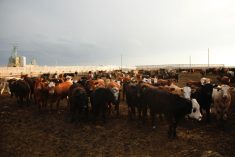Western Canadian feeder cattle markets traded steady to $5 higher compared to week-ago levels. Buyers were quite meticulous on flesh levels and quality features in the heavier weight categories; however, feedlot operators were definitely more aggressive this week. Major operations have liquidated a fair amount of fed cattle and these players are anxious to reload with margins are the current levels.
Although direct sales from backgrounding operators were noted, Alberta feedlots stretched orders across the Prairies, taking the focus off local supplies. Order buyers in the eastern Prairies were inundated with calls as Ontario demand was also evident. Alberta packers were buying fed cattle at $165, about $25 above break-even pen closeouts. These are the highest finishing margins we’ve seen in the last 30 months. Calves were also quite firm, trading at times $4-$6 above week-ago levels. Pasture conditions will be optimal come spring and the market experienced strong interest in grassers. Grass cattle tend to deteriorate later in spring so buyers weren’t willing to gamble by waiting on price and quality.
Read Also

Alberta crop conditions improve: report
Varied precipitation and warm temperatures were generally beneficial for crop development across Alberta during the week ended July 8, according to the latest provincial crop report released July 11.
Mixed average-frame steers weighing 900 lbs. with medium flesh were a solid $160 in central Alberta; heifers of similar weight and quality were quoted at $142 in the same region. Larger-frame Simmental-cross steers with medium to lower flesh were quoted at $164 in southern Alberta; in Manitoba, medium- to larger-frame 800-lb. mixed steers with medium flesh were quoted from $162 to $165. Steers averaging 600 lbs. were quoted from $196 to $200 across the Prairies with larger frames reaching up to $204. Heifers were quite variable which made the market hard to define. Mixed Charolais-based heifers averaging 700 lbs. were quoted at $157 in southern Alberta while 625-lb. medium- to larger-frame heifers were trading from $164 to $166.
Wholesale choice beef prices jumped $6, reaching over $194/cwt this past week. The fed market is experiencing seasonal low beef production while moving into a relatively strong demand period, which is spilling over into the feeder complex. At the same time, feed barley has dropped $15 per tonne from the higher levels earlier in winter, down to $150 per tonne delivered Lethbridge. We could see the feeder market percolate higher over the next three to four weeks. When the fed cattle turn lower, feeder prices will prolongate the higher levels but eventually fade on a three- to five-week lag.
— Jerry Klassen is manager of the Canadian office for Swiss-based grain trader GAP SA Grains and Produits. He is also president and founder of Resilient Capital, which specializes in proprietary commodity futures trading and commodity market analysis. Jerry owns farmland in Manitoba and Saskatchewan but grew up on a mixed farm/feedlot operation in southern Alberta, which keeps him close to the grassroots level of grain and cattle production. Jerry is a graduate of the University of Alberta. He can be reached at 204-504-8339.




















